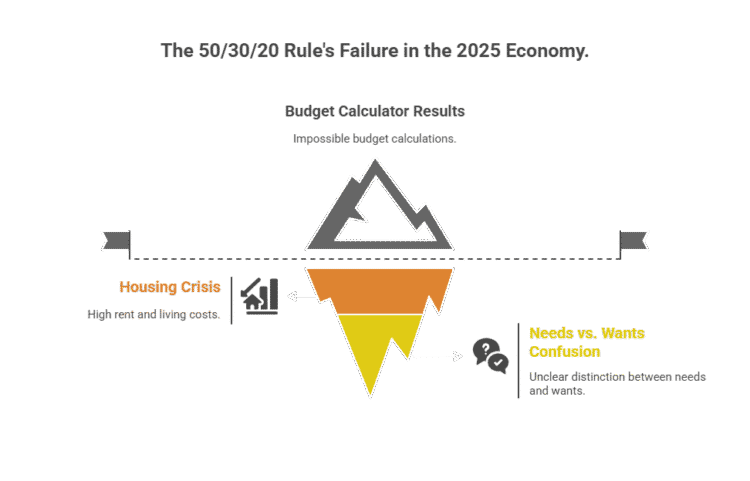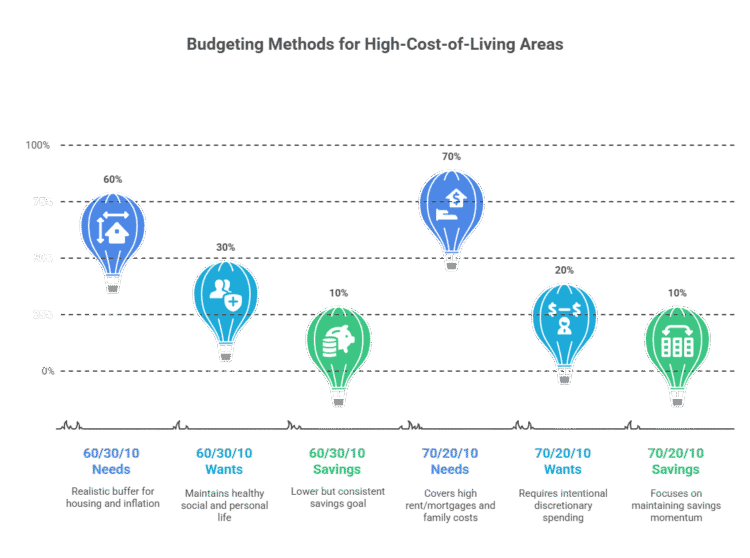Let’s start with the hard truth: the 50/30/20 budgeting rule is a beautifully simple idea that is failing millions of Americans. Just last month, in mid 2025 I had a client, a sharp 30-year-old nurse I’ll call Leah, sit across from my desk, utterly defeated.
‘My rent alone is 45% of my take-home pay, Michael,‘ she said. ‘Am I supposed to live on the other 5%?’
My unique take is this: The 50/30/20 rule isn’t a budget; it’s a diagnostic tool.
Its job isn’t to make you feel guilty; its job is to reveal the financial pressure points in your life.
The fact that the average renter needs to earn over $90,000 to afford a two-bedroom apartment, according to the National Low Income Housing Coalition’s 2024 report, proves the map is outdated.
So, is the rule 50/30/20 useless? No. But are you using it wrong? Almost certainly.
What is the 50/30/20 Budget Rule? (Your Quick Refresher)
Before we can adapt the 50/30/20 rules, we have to know them. The 50/30/20 framework, popularized by Senator Elizabeth Warren in her book, “All Your Worth: The Ultimate Lifetime Money Plan“ (Amazon link) divides your after-tax income into three simple categories:
- 50% for Needs:
Essential, non-negotiable expenses like housing, utilities, groceries, transportation, healthcare, and minimum debt payments. - 30% for Wants:
Discretionary, lifestyle spending on dining out, entertainment, subscriptions, hobbies, and travel. - 20% for Savings and Debt Repayment:
Building your future through emergency funds, retirement contributions (like a 401(k) or IRA), investments, and extra debt payments.
Ready to see how your numbers stack up? Use this simple 50/30/20 budget calculator below as a reality check.
Interactive 50/30/20 Budget Rule Calculator
The 50/30/20 rule is a guideline. Your ideal budget may vary based on income, location, goals, and debt levels. Focus on progress, not perfection!
Get More Financial Insights & Tools!
Subscribe to NewsletterSee an issue or have a suggestion? We'd love to hear from you!
Why the 50/30/20 Rule Fails in the 2025 Economy
Did your numbers in the 50/30/20 udget calculator above look impossible? You’re not alone. The economic landscape of 2025 has stretched this 20-year-old framework to its breaking point.
1. The Housing Crisis Obliterates the 50% “Needs” Category
The framework’s primary breaking point is the 50% ‘Needs’ category. I had clients in 2024, a young couple in Denver, whose combined ‘Needs’ aka rent, student loan minimums, and childcare, hit 72% of their after-tax pay. They weren’t frivolous; they were simply living in a 2025 economy.
Here’s a data point competitors miss: The Federal Reserve Bank of St. Louis noted that the ‘rent-to-income’ ratio has been structurally above 30% for over a decade. That isn’t a temporary spike; it’s a new economic reality.
The problem isn’t your discipline; it’s the math.
2. The “Gray Area”: The Confusion Between Needs and Wants
The simple “Needs vs. Wants” division falls apart under scrutiny.
- Is your gym membership a “Want,” or a “Need” for physical and mental health?
(My take: if it prevents future medical bills, it’s a need). - Is childcare a “Need” to enable work, or does it fall elsewhere?
(It’s a Need, and a huge one). - Are student loan payments a “Need” or part of the “Savings & Debt” bucket?
(Minimums are a Need; extra payments are a Savings & Debt item).
This confusion is where most budgets fail. Not from a lack of discipline, but a lack of clarity.
Realistic 50/30/20 Budgeting Alternatives for High-Cost-of-Living Areas
If the classic rule is broken, what do you do? You don’t give up; you adapt.
Here are the realistic budgeting frameworks for 2025.
The 60/30/10 Method: A Temporary Adjustment
This model acknowledges today’s higher essential costs and is a great fit for young professionals.
- 60% for Needs: A realistic buffer for housing and inflation.
- 30% for Wants: Maintains a healthy social and personal life.
- 10% for Savings: A lower but still consistent savings goal.
As Michael Finke, a wealth management professor, told TIME Magazine, this approach lets you build good habits and then “gradually… increase that savings rate.”
The 70/20/10 Method: The High Cost-of-Living Strategy
For families in expensive urban areas, this approach prioritizes reality. Research from HyperJar found 83% of people can’t follow the 50/30/20 rule.
- 70% for Needs: Covers high rent/mortgages and family costs without guilt.
- 20% for Wants: Requires more intentional discretionary spending.
- 10% for Savings: Focuses on maintaining momentum.
The Michael Ryan Money “Budget Dial”: Customizing for Your Income & Life Stage
Your financial priorities aren’t static. Think of these percentages as dials you can adjust.
For High Earners:
If you make six figures, saving only 20% is a wasted opportunity. You should be dialing your savings up to 30%, 40%, or even 50% to aggressively build wealth and fight lifestyle creep.
For Freelancers & Irregular Incomes:
I’ll never forget ‘Freelancer Felix,’ a graphic designer who came to me totally stressed. His income was a rollercoaster, and the 50/30/20 rule was useless. We ignored monthly percentages and created his ‘Annual Survival Number’. The total cost of his ‘Needs’ for a year.
From every single paycheck, he transferred 40% to a separate ‘Tax & Salary’ account, from which he paid himself the exact same salary every month. It smoothed out the peaks and valleys, giving him predictability and peace of mind.
For Debt Warriors:
When you’re tackling high-interest debt, you’re in a financial emergency. Dial your “Wants” down to 10-15% and turn your “Savings & Debt” dial up to 30%+.
Pro-Level Tactic: The “Financial Triage Protocol” for Your Savings
Treating your 20% ‘Future’ bucket as a single monolith is where amateur budgets die. A professional gives every dollar a mission.
For my clients, I use a framework I call ‘The Michael Ryann Money Financial Triage Protocol.’ It’s not just a list; it’s an order of operations for your money.
- Stop the Bleeding (Emergency Fund):
Your first 5% of income goes here until you have $2,000. Not a penny goes anywhere else. - Treat the Major Wounds (High-Interest Debt):
The next 10% is a targeted missile at any debt over a 7% interest rate (credit cards, personal loans). - Build Long-Term Health (Retirement):
The final 5% is for tax-advantaged retirement investing. This isn’t just dividing your money; it’s sequencing it to have the maximum impact.
50/30/20 Budget Frequently Asked Questions (FAQ)
How does the 50/30/20 rule handle taxes and other paycheck deductions?
The rule applies to your after-tax, take-home pay. It’s the net amount that hits your bank account after taxes, health insurance premiums, and pre-tax 401(k) contributions are deducted.
What if my Needs are way over 50%?
The rule didn’t fail you—it successfully diagnosed that you have either an income problem or a cost-of-living problem, not a budgeting problem. Now you know the real issue to solve.
Is a budgeting app better than this rule?
They work together. The 50/30/20 rule is your high-level strategy. Apps like YNAB or Monarch Money are the tools for day-to-day execution.
Final Take: Your Budget is a Compass, Not a Cage
The 50/30/20 rule isn’t a pass/fail test. It’s a powerful tool to give you a starting snapshot of your financial life. The real magic happens when you give yourself permission to adjust the dials, creating a personalized spending plan that reflects your reality. True financial control isn’t about fitting into a perfect box; it’s about using data to make intentional choices.
Want to apply this framework yourself? Download my free one-page “Budget Dial Worksheet” to find the perfect percentages for your financial life and start building a budget that finally feels achievable.
Disclaimer: This article is for informational purposes only and is not financial advice. Consult with a qualified professional before making any financial decisions.
- Sharing the article with your friends on social media – and like and follow us there as well.
- Sign up for the FREE personal finance newsletter, and never miss anything again.
- Take a look around the site for other articles that you may enjoy.
Note: The content provided in this article is for informational purposes only and should not be considered as financial or legal advice. Consult with a professional advisor or accountant for personalized guidance.






